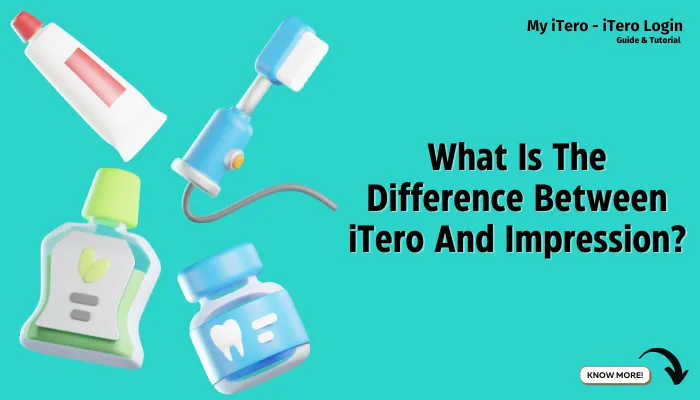What is the difference between iTero and impression? In modern dental practices, the method for taking impressions of your teeth has undergone significant transformation, particularly with the advent of the iTero scanner and its accompanying iTero portal. Traditional impressions involved the use of a putty-like material that many patients found uncomfortable and messy.
This guide will explore the key differences between traditional impressions and iTero, highlighting the benefits of embracing digital dentistry for a more comfortable and efficient patient experience.

Introducing iTero
Explore how iTero is changing the dental impression making procedure with an indigenously developed digital system.
What Is iTero and how it works?
Having dealt with the state of the art impressions, let us articulate the thought: How do iTero and impression differ? This is a digital scanning system which takes 3D images of the patients’ teeth and the gums.
- Preparation: the mouth of the patient is dried and the mouth is ready for scanning.
- Scanning: A wand-like apparatus to take images of the patient’s teeth and gums is used.
- Processing: This is an aspect where the scanner and the software integrates whereby the software begins to analyze the taken images by the scanner.
- Review: The 3D image captured can be viewed by the dental professional on screen even while capturing it.
- Refinement: If further scans are required for accuracy, they can be initiated.
- Storage: A digital file containing the design will be created and could become available anytime.
Advantages of iTero
- Excellent precision and accuracy
- Less discomfort for the patients
- Results which are immediate and viewable
- Digital files can be easily stored and shared
- Changes can be made on the spot
Disadvantages of iTero
- Higher initial cost for equipment
- New skill acquisition required on part of dental consultants
- Dependence on the equipment and worries of malfunctions
Traditional Impressions in Dental Practice
Let’s look back in history at the use of the conventional techniques of taking dental impressions.
What Are Those Traditional Dental Impressions?
Some of you may wonder what these differences are and why they are important, but this will come later because, first, let us define a few terms including, what is a traditional dental impression:
- Definition: A dental impression is a negative impression of teeth and the soft tissues surrounding them.
- Purpose: For the construction of a perfect reproduction of a patient’s mouth for procedures performed.
- Materials: Usually composed of alginate or polyvinyl siloxane (PVS) materials.
Workflow For Making A Traditional Dental Impression
- Preparation: The dentist fits the tray with the correct measure.
- Application: A batch of the impression material is prepared and put in the tray.
- Placement: The tray is positioned in the patient’s mouth and brought in contact with the teeth.
- Setting: The material sets and there is a release of heat as it gets rigid leading to forming of dental structures.
- Removal: The tray is taken out of the mouth with caution.
- Casting: Constructing a positive model using the negative impression.
Common Benefits That Re-purpose The Impressions
- Comfort: This is a technique which most dentists have worked with.
- Affordability: This is usually cheaper than going for digital ones.
- Non-technology based: This is possible without sophisticated devices.
Disadvantages of Traditional Impressions
- Risks of error because there will be shrinking of materials or more twisting
- Beauty discomfort, especially in those patients who experience a high gag response
- This is time requiring
- Physical models required storage and transportation might also be a problem
iTero vs. Traditional Impressions: A Comprehensive Comparison
In order to put these differences into perspective, let us consider a few factors and see how the two; iTero and traditional impressions compare:
| Factor | Traditional Impressions | iTero |
|---|---|---|
| Method | Physical mold | Digital scan |
| Time required | 15-20 minutes | 3-5 minutes |
| Patient comfort | Can be uncomfortable | Generally more comfortable |
| Accuracy | Good, but human interference errors are inevitable | Very high accuracy |
| Immediate results | No | Yes |
| Storage | Physical models | Computerised records |
| Ease of sharing | Transfer of files needs physical movement | Sharing of files via the web |
| Cost per impression | Cheaper | More expensive at first, cheaper in the long term |
| Environmental impact | Employs disposable materials | No waste generation |
In conclusion, What is the difference between iTero and impression? iTero offers a faster, more comfortable, and accurate digital alternative to traditional impressions, with easier file sharing and no waste. While initially more expensive, iTero can be cost-effective in the long run and environmentally friendly.
Key Differences Explained
Delve deeper into the specific areas where iTero and traditional impressions diverge significantly.
1. Technology
What is the difference between iTero and impression concerning technology? Traditional impressions are made by use of physical substances, while iTero is fitted with medial optical technology, which assists in the development of the 3-dimensional models.
2. Patient Experience
Considering patient experience and comfort, what is the difference between an iTero and an impression? An iTero usually makes the extraoral scanning procedure even more bearable especially for people with sensitive gag reflex.
3. Accuracy and Precision
Considering accuracy how does iTero compare with an impression? While the impression may be accurate, iTero is a highly precise digital system that performs better than the conventional systems in most complex cases.
4. Time Efficiency
What is the difference between iTero and impression in terms of time? iTero decreases chair time tremendously thereby making it possible to see more patients in a day within shorter appointment periods.
5. Visualization and Communication
With regard to patient education, what is the difference between iTero and impression? Due to iTero’s instant 3D models, dentists have less trouble with explaining procedures to the patient, who in turn forgets almost nothing about the treatment plan.
Making the Choice: iTero or Traditional Impressions?
In comparing iTero against traditional impressions, factors such as the following should be considered:
- Provider practice size and patients in the clinic
- Procedure types which the providers usually do
- Need to acquire equipment and materials
- How loathe or willing one is to go digital
- Engage patient characteristics and preferences
Future of Dental Impressions
Since technology is always improving, it is very likely that the dental profession will also improve their scanning devices which are presently in place and used instead of impressions. Nevertheless, it is likely that some situations will still require the use of traditional impressions.
Potential Developments:
- Scanning of teeth in lesser time than before
- Attachment to other dental devices
- Better forms of materials to do impression
- Combination of digital system with traditional ways
Conclusion
What is the difference between iTero and impression? The answer lies in comfort, speed, accuracy, and overall patient experience. While traditional impressions still have their place in dental practices, iTero digital scanning is increasingly becoming the preferred method due to its many benefits.
The move toward digital dentistry offers patients and dentists alike a faster, more accurate, and much more comfortable experience, paving the way for future advancements in dental care.
